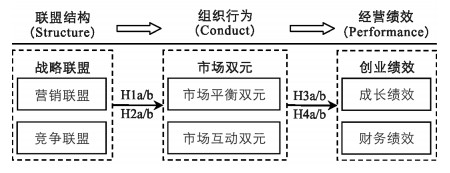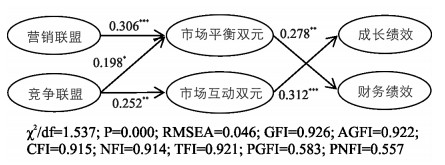全文HTML
-
在创新创业与乡村振兴的双重时代要求下,农村创业在推动新农村建设与脱贫攻坚,提高农村就业率,实现农村减贫,降低返贫率等方面具有重要意义[1]。但是,农村创业仍然面临人才资源匮乏、市场信息闭塞、科技力量缺乏、创业资金不足等诸多挑战,使农村创业企业面临资源约束、能力缺乏、市场网络不畅等生存困境[2]。因此,农村创业企业需要建立战略联盟,构建多维合作网络,以获取生存及发展所需的各类关键资源。
战略联盟是创业企业克服自身资源与能力缺陷,获取外部资源以实现生存和发展的重要手段[3],因而得到国内外研究的持续关注。虽然战略联盟研究已经持续近五十年并取得丰富成果,但仍然存在一些不足。例如,现有战略联盟的研究大多围绕集团企业或跨国企业展开,较少聚焦创业情景的战略联盟分析,更缺乏基于农村创业背景的战略联盟研究[4]。更为重要的是,已有战略联盟的作用研究存在不一致的结论:一方面,有研究认为企业之间的联盟及合作能够使参与方受益,对企业带来诸如克服市场壁垒、加快新产品开发、获取合法性等方面的积极影响[5]。另一方面,一些研究则指出,虽然战略联盟可以创造经济价值,但是大多数情况是联盟中的优势方获益,而并不能为所有联盟企业带来益处[6]。因此,战略联盟的“效应悖论”无法有效指导农村创业企业运用战略联盟实现企业持续成长。
农村创业者因人情关系、知识结构和管理经验等方面的限制,更容易产生“短期”创业行为,使农村创业企业无法在满足当前需求的同时有效开发潜在需求,进而为企业的持续成长带来挑战[7]。双元理论强调,以探索与开发为内核的市场双元是企业合理兼顾利用现有市场与培育未来市场的关键市场行为[8]。因此,农村创业企业形成市场双元对确保农村创业者成功以及农村创业企业成长具有重要意义。基于以上分析,本研究依据“结构-行为-绩效”分析框架,将农村创业企业战略联盟划分为营销联盟和竞争联盟,在考察市场双元中介效应的基础上,探究战略联盟与创业绩效的逻辑关系,明确战略联盟农村创业企业绩效的影响路径。
-
战略联盟是指两个及以上的企业为实现特定目标建立的合作关系或网络,它涉及资源的交换与分享,是企业重要的外部资源基础[9]。战略联盟能够帮助企业克服资源与能力的限制,实现重要的战略目标并获取竞争优势[10];对创业企业而言,构建或嵌入战略联盟是克服自身“新创劣势”,整合外部资源实现价值创造和企业成长的关键手段[4]。因此,对战略联盟的探讨已经从传统的战略管理领域逐渐渗透到创新及创业的分析范畴。
虽然对战略联盟内涵的理解较为一致,但对其类型的探讨因研究对象和分析情景的差异而有所不同:有的研究从联盟导向视角,将战略联盟划分为合法性导向联盟和能力导向型联盟[11];而有的研究则根据联盟形式,将战略联盟划分为股权联盟、非股权联盟、合资企业和混合联盟四种类型[3];还有研究从联盟属性及参与企业特征的角度,认为战略联盟包含探索式技术联盟和开发式商业联盟两类[12];也有研究基于中小企业发展阶段将战略联盟分为深思熟虑型、探索型、即兴型和战略型四种[13]。可见,对战略联盟类型的理解,因联盟企业特征及分析情景的不同而存在不同的观点。
在农村创业活动中,创业企业既需要通过战略联盟利用市场资源“开疆拓土”,例如农产品加工企业借助市场网络销售产品;又需要同业企业之间“抱团发展”,以实现资源共享和成本共担,例如乡村旅游企业共同开发市场。因此,农村创业企业战略联盟可以视为创业企业为整合和利用外部资源,围绕产业链构建的具有共同目标和行动规范的合作网络。同时,本研究借鉴李薇和龙勇、Pedada等的观点[14-15],根据农村创业企业所构建战略联盟在产业链中的构型,将战略联盟划分为营销联盟和竞争联盟。营销联盟是创业企业与产业链下游承担产品或服务传递及维护功能的企业所建立的合作网络,是纵向结构的战略联盟。而竞争联盟作为横向结构的战略联盟,是由向市场提供相同或相互替代的产品的竞争企业所构建的合作网络。无论是纵向结构的营销联盟还是横向结构的竞争联盟,都是农村创业企业弥补自身资源短板,实现生存和发展的外部资源网络。
-
创业企业大多面临新的市场需求和未知的竞争环境,利用旧的确定性和发掘新的不确定性是创业企业生存和成长的必然要求[16]。双元理论认为,市场探索表明创业企业运用现有市场知识或技术创造面向未来需求的市场供给;市场开发则反映创业企业整合现有市场知识或技术满足当前市场需求。实现市场探索与开发活动“兼顾”即双元,是创业企业满足现有需求和着眼未来市场的关键。市场双元不仅是农村创业企业解决市场“短视”问题,增强企业生命力,维持长期绩效的重要条件;还是农村创业减贫,同时避免因创业失败而返贫的组织条件。根据组织双元的新近观点[17-18],本研究将市场双元视为创业企业面向当前与未来市场时,均衡开展市场探索与开发的组织行为,体现为平衡双元和互动双元两种基本形式:前者反映创业企业市场探索与开发活动的一致程度;后者体现创业企业市场探索与开发活动的互动水平。
目前,战略联盟与市场双元的关系研究还比较少,但是战略联盟与探索、开发及组织双元性的研究结论仍能够提供重要指引。在营销联盟方面,外部市场资源的有效整合能使农村创业企业及时满足现有需求并发掘潜在需求,即实现市场双元[19]。一方面,农村创业企业需要利用市场网络或销售渠道进行产品推广,而来自营销联盟的各类渠道及人员资源能够弥补农村创业企业营销资源的不足;这不仅能够为企业充分满足现有市场提供支持,避免市场风险,还能够帮助企业关注需求趋势,使市场利用和探索活动更为均衡[20]。另一方面,农村创业企业因所处地域和社会网络限制,缺乏足够的行业及市场信息,因而需要通过营销网络获取市场资讯。有研究表明,相较于身处信息发达区域的企业,农村创业企业更关注眼前利益,自身具有更强的机会利用动机,因而表现为更倾向于攫取当前市场机会[21]。然而,来自市场端的需求及顾客特征信息,能够驱使农村创业企业在利用市场的同时接触和掌握市场趋势及需求变化特征,提升市场开发与市场探索在企业内的互动水平[15]。
综上所述,作为纵向结构的营销联盟,能够为农村创业企业补充产业链下游的市场及顾客信息、推广渠道等营销资源,驱动农村创业企业降低“短期市场诉求”,在保持利用现有市场与发掘潜在市场的同时,还能够使探索与开发活动在组织内进行良性互动。因此,提出如下假说:
H1a:农村创业企业营销联盟对市场平衡双元有积极影响;
H1b:农村创业企业营销联盟对市场互动双元有积极影响。
以信用合作、供销合作、生产合作为内核的“三位一体”农村生产互助组织是农村创业企业成长和发展的重要依托,尤其是以提供相同或相似产品或服务的同业企业组成的合作组织是农村创业企业克服自身资源局限,实现“抱团发展”的必然选择[1]。事实上,竞争联盟不仅在壮大产业集群、提升产业影响力等方面扮演不可或缺的角色,还在改善联盟内企业资源配置、优化企业运营方式等方面作用显著[22]。首先,农村创业企业组成的区域性或产业性竞争联盟,能够强化关键经营资源共享,并且分担产业开发或市场培育的潜在风险或前期投入[21]。资源共享与成本共担能够使创业企业在聚焦现有市场和培育潜在市场两方面进行均衡资源匹配,既合理控制风险满足现有市场,又充分利用外部资源挖掘潜在需求。其次,在农村合作社等各类经济互助体系中,具有不同的经历、知识结构和个性特征的农村创业者能够相互学习和借鉴,从而形成聚焦现实与面向未来的交互学习机制[23]。这意味着,有效的学习机制能强化组织探索与开发活动的互动性。此外,Calza等对欧洲旅游行业农村创业者的研究也表明,不同国家文化背景下的创业者之间进行良性互动,能够推动组织探索与开发活动的有效交互[24]。
总之,农村创业企业建立产业链上横向结构的联盟可以形成资源共享和风险共担机制,进而从资源投入方面确保市场探索与开发的动态平衡;同时,不同专业背景、知识结构和从业经历的同业创业者之间建立学习机制,有助于市场探索与开发在创业中保持良性互动。据此,提出研究假说:
H2a:农村创业企业竞争联盟对市场平衡双元有积极影响;
H2b:农村创业企业竞争联盟对市场互动双元有积极影响。
-
农村创业企业转变为双元组织,通过市场双元应对持续变化的市场环境与顾客需求,有助于优化创业绩效,切实促进农民增产增收,实现产业兴农与乡村振兴。农村创业企业的市场平衡双元意味着企业在利用现有市场和培育潜在市场方面投入相对平衡的注意力和资源,确保市场探索与开发活动具有较高的一致水平[25]。有关营销探索与开发战略研究指出,探索与开发活动的平衡能够为企业开拓市场空间,获取发展潜力奠定基础[26];而彭正龙等基于能力视角强调,营销探索与开发能力的高度平衡,能够为企业持续成长提供驱动力[27]。同时,创业企业较好地平衡探索与开发活动,以渐进的方式将持续的市场收益投入新市场的培育,有助于企业拥有健康的现金流,并降低资金风险,从而实现更好的财务绩效[24]。
由此可见,农村创业企业有效平衡市场探索与开发活动,能够以渐进的方式拓展企业市场空间,从而获取较高水平的成长绩效;同时也能够在确保当前收益的前提下投资于未来需求培育,以健康可持续的资源投入模式获得可观的财务回报。因此,研究假说如下:
H3a:市场平衡双元对农村创业企业成长绩效有积极影响;
H3b:市场平衡双元对农村创业企业财务绩效有积极影响。
市场互动双元表明创业企业的市场探索与市场开发活动之间有高水平的交互效应[16]。现有研究表明,互动双元的组织绩效集中表现为创新产出,这意味着探索与开发的有效交互积极影响创新行为及绩效[28]。因此,市场互动双元通过驱动创新行为能够对农村创业企业绩效产生积极影响。一方面,市场互动双元显著影响农村创业企业的成长绩效。Voley等对中小企业的研究表明,探索与开发活动的高水平互动是成长导向型企业的提升绩效水平的关键[29]。此外,在国际创业情境下,企业探索与开发活动的互动能够为高科技国际新创企业带来竞争优势,进而推动企业的国际市场扩张[30]。另一方面,高水平的市场互动双元能够改善农村创业企业的财务绩效。Tirado等对商业银行的研究表明,市场层面的探索与开发互动,能够驱动产品及服务创新,从而为企业带来更高的品牌溢价和竞争优势,从而优化财务绩效[31]。
综上所述,农村创业企业在市场探索与开发方面的良性互动,可以促进产品/服务开发及市场化的创新,不仅能够增强市场竞争力,扩展企业及市场规模,还能够通过品牌溢价与市场优势优化企业财务绩效。据此,研究假说如下:
H4a:市场互动双元对农村创业企业成长绩效有积极影响;
H4b:市场互动双元对农村创业企业财务绩效有积极影响。
基于“结构-行为-绩效”分析框架及研究假说发展,构建本研究的概念框架如图 1所示:
一. 农村创业企业战略联盟的内涵与类型
二. 农村创业企业战略联盟与市场双元
三. 农村创业企业市场双元与创业绩效
-
研究通过问卷调查获取实证数据以验证研究假说,对所涉及概念的测量均借鉴或改编已有量表。战略联盟包括营销联盟和竞争联盟两类:营销联盟的测量问项改编自Swaminathan和Moorman[19],以及Moghaddam等[4]的研究工具,从市场资源获取的角度对营销联盟进行测量;借鉴Soekijad和Andriessen[22],以及李薇和龙勇[14]的理论观点,从同业企业的资源共享和风险共担两大层面对竞争联盟水平进行测量。对市场双元的测量借鉴Zhang等[25]的测量工具,分别对市场探索和市场开发进行测量,其中,市场探索聚焦于潜在市场开发的组织行为,市场开发关注创业企业对现有市场的利用和满足。本研究考察市场双元两种形式,即平衡和互动。一方面,市场平衡双元反映农村创业企业市场探索与开发二者的相对平衡水平。研究用市场探索(MEr)与市场开发(MEi)测量值之差的绝对值来表示,即“|MEr-MEi|”;同时,为方便解释,用5减|MEr-MEi|来反映匹配均衡水平,即该值越高,则市场平衡双元水平越高。另一方面,市场互动双元反映农村创业企业市场探索与开发之间的互动水平。研究用市场探索(MEr)与市场开发(MEi)测量值的乘积进行评价,即“MEr×MEi”。
创业绩效分为成长绩效和财务绩效两个方面,借鉴Tirado等[31]的研究工具,从销售额、市场份额和员工数量三个方面对成长绩效进行测量;对财务绩效的测量问项改编自李巍[17]的研究工具,主要从企业的利润水平、投资回报率和现金流三个方面进行测量。同时,研究根据农村创业企业的特点,考虑可能影响分析结论的两类控制变量:(1)企业年龄分为2组:大于1年且小于42个月=1,42个月至6年=2;(2)企业规模以正式员工进行衡量,分为5组:少于20人=1,20至39人=2,40至59人=3,60至79人=4,80人以上=5。除了控制变量以外,所有测量问项均使用李克特5点量表(1=完全不同意,5=完全同意)。最终形成包含21个主体问项的调查问卷。
-
研究整合有关农村企业和创业企业的观点[7, 11],将成立时间超过1年但低于6年,且注册地和经营场所均在乡镇的企业界定为农村创业企业,作为本研究的数据收集对象。研究通过重庆市青年创新创业学院(共青团重庆市委、重庆市青年创新创业服务中心主办)举办的、面向重庆市各区县农村创业者的创业训练项目,向符合调查对象要求的创业者发放调查问卷。数据收集的主要步骤是:首先,在创业培训项目开展间隙,调查人员向被调查对象就研究问题、专业术语进行讲解,特别是考虑到农村创业者的文化程度和专业背景等方面的特殊性,研究者详细地向被调查者阐述农村创业企业的界定以及调查议题的核心内容,最后选择符合要求且愿意参与研究的被调查者。然后,研究人员向被调查者逐一讲解问项内容,同时邀请被调查者对每个问题逐一进行回答。最后,研究人员整理调查问卷,对遗漏或矛盾的地方进行补充访谈,以确保问卷填写的完整性和规范性。
调查历时一个月,累计向符合要求的来自重庆市各区县农村创业者发放调查问卷200份,有效回收问卷195份。由于是现场讲解后向被调查者发放、回收和复核问卷,因而调查问卷的有效回收率比较高。样本企业主要以农村电商、农业观光旅游及农产品加工企业为主,具体情况如下:企业年龄,大于1年且小于42个月的企业107家(占比54.87%),大于42个月且小于6年的企业88家(占比45.12%);企业规模,少于20人的企业63家(占比32.31%),20人至39人的企业52家(占比26.67%),40人至59人的企业36家(占比18.46),60至79人的企业35家(占比17.94%),80人以上的企业9家(占比4.62%)。
一. 变量测量与问卷开发
二. 数据采集与样本情况
-
研究运用Cronbach's α值及修正问项总相关系数(CITC)两项指标对核心概念的测量信度水平进行评估。数据显示(表 1),全部核心概念的α值在0.831至0.903之间,均高于0.7水平;且全部测量问项的CITC值均高于0.4水平。结论表明,研究所用测量问项的内部一致性达到要求,核心概念的测量信度水平比较理想。
本研究对核心概念的测量均借鉴或改编已有量表,并根据分析情景对措辞进行修正和完善,进而确保了测量的内容效度。对测量收敛效度的检验通过验证性因子分析进行。运用AMOS 19.0的验证性因子分析结论显示(表 1),全部测量问项的标准化因子载荷在0.703~0.811之间,均高于0.5水平且在0.01水平下显著,表明核心概念测量的收敛效度比较理想。
对测量判别效度的检验综合运用Pearson相关系数和平均提炼方差(AVE)平方根两项指标。数据显示(表 2),在95%置信区间里,任意概念之间的相关系数不为1,且概念的AVE值平方根大于其所在行/列相关系数的绝对值,结论表明核心概念测量的判别效度也达到要求。
-
研究通过文献回顾和假说发展认为市场双元在战略联盟与创业绩效关系中扮演中介角色。为确保运用结构方程模型进行假说检验的准确性,首先需要对市场双元的中介效应进行评估,确定中介效应的形式与程度,即明确市场双元在战略联盟与创业绩效关系中是部分中介作用还是完全中介作用。
根据Baron和Kenny[32]的方法建议,研究运用三步回归法对市场双元中介效应进行检验(表 3):第一步,将中介变量市场平衡双元(β=0.312,p<0.001)和互动双元(β=0.287,p<0.001)分别与自变量战略联盟回归,回归系数显著。第二步,将因变量创业绩效与自变量战略联盟回归,回归系数也比较显著(β=0.212,p<0.05)。第三步,将因变量创业绩效同时与自变量战略联盟,及中介变量市场平衡双元和互动双元回归;中介变量平衡双元(β=0.293,p<0.001)和互动双元(β=0.285,p<0.001)回归系数比较显著,而创业绩效与战略联盟的回归系数不显著。结论表明,市场双元在战略联盟与创业绩效的关系中发挥着完全中介作用。
-
根据假说发展和中介效应检验结论,研究使用AMOS 19.0构建结构方程模型,通过路径关系分析检验研究假说。在输出的结构方程模型中,各项模型拟合度指标值(绝对拟合度GFI和AGFI大于0.9,增值拟合度CFI、NFI和TFI大于0.9,简约拟合度PGFI和PNFI大于0.5)均达到或优于标准值水平(图 2),表明模型的拟合度达到要求,可以用于假说检验。结构方程模型分析表明(图 2):
首先,营销联盟对市场平衡双元(β=0.306,p<0.001)有显著影响,但对市场互动双元没有显著作用,即H1a得到支持,H1b未通过验证。结论表明,营销联盟对市场平衡双元有积极作用,但对市场互动双元影响不显著。作为产业链上纵向结构的营销联盟,能够弥补农村创业企业在顾客调研、市场推广及销售渠道等营销资源与技能方面的不足,帮助农村企业更好地避免市场风险,提供市场网络支持以使企业更好地满足当前市场需求的同时,更好地关注和理解市场趋势,通过市场端的反向作用,促使农村创业企业克服短期经营倾向,实现市场探索与开发的平衡。营销联盟对市场互动双元没有显著影响,表明在纵向结构的联盟中更多的是市场资源的传导和运用,没有形成有效的学习机制,无法有效地推动组织创新,进而不能显著地促进农村创业企业市场探索与开发活动的交互。
其次,竞争联盟对市场平衡双元(β=0.198,p<0.05)和市场互动双元(β=0.252,p<0.01)均有积极影响,即H2a和H2b均得到证实。结论表明,竞争联盟对市场平衡双元和互动双元均有正向作用。竞争联盟是农村创业企业在产业链上构建的横向结构联盟,是由提供相似或相互替代产品的企业组成的合作网络。在农村创业中,以信用合作、供销合作、生产合作为内核的“三位一体”农村生产互助组织是催生和帮扶农村创业企业发展的重要网络。由于农村创业者在知识结构、社会关系和经济资源方面的局限,“抱团发展”是农村创业企业生存和发展的必然选择。无论是农村电商,还是农产品加工,抑或农村特色旅游等领域,同业企业联合进行技术普及、市场推广和顾客服务是壮大产业集群,实现特色产业的关键手段。竞争联盟对市场平衡双元和互动双元均有积极作用,已经表明竞争联盟内的农村创业企业可以通过资源共享和风险共担的模式,以及农村创业者之间的学习机制实现市场探索与开发的平衡和互动。
最后,市场平衡双元对成长绩效没有显著影响,但对财务绩效(β=0.278,p<0.01)有积极影响,即H3a未得到支持,H3b通过检验;市场互动双元对成长绩效(β=0.312,p<0.001)有积极影响,但对财务绩效作用不显著,即H4a通过检验,H4b未被证实。假说检验结果说明,市场双元是联结战略联盟与创业绩效的重要组织行为,其中市场平衡双元与财务绩效紧密关联,而市场互动双元与成长绩效关系显著。一方面,市场平衡双元表明农村创业企业在利用现有市场和培育潜在市场方面给予更为均衡的资源投入,实现市场开发与探索活动在组织内部的相对平衡。市场平衡双元聚焦于营销资源在满足现有市场与培育潜在市场方面的平衡,通过渐进的方式将市场收益持续地运用到新市场培育,从而能够确保创业企业拥有健康的现金流,降低或避免资金风险,从而显著提升财务绩效。另一方面,市场互动双元表明农村创业企业的市场探索与开发活动具有较高水平交互,能够有效驱动市场创新行为。市场探索与开发交互带来的创新效应,能够帮助农村创业企业更好地满足市场需求,并为培育潜在市场提供创新型的产品或服务,从而使创业企业能够赢得市场竞争并扩展市场规模,进而推动企业规模的扩张,最终表现为成长水平的大幅提升。
一. 信效度检验
二. 中介效应检验
三. 主效应检验
-
研究依据“结构-行为-绩效”的分析框架,在区分营销联盟和竞争联盟基础上,借鉴双元理论从市场双元视角厘清战略联盟与农村创业企业绩效的逻辑关系,为农村创业企业构建战略联盟,优化创业绩效提供了理论指引。
研究的理论价值主要体现在:第一,当前对创业企业的研究已经十分丰富,但针对农村创业企业的探讨还非常不足。研究运用“结构-行为-绩效”分析框架探讨农村创业企业战略联盟议题,整合创业学与战略管理研究,丰富了农村创业企业成长的理论研究。第二,本研究从联盟结构的角度对农村创业企业战略联盟进行分类和测量,特别是对横向结构的竞争联盟探讨,不仅契合农村创业实践,更丰富了对战略联盟的类型理解。第三,研究从市场双元的角度,厘清了战略联盟与创业绩效的内在关系,不仅回应了战略联盟“效应悖论”问题,深化战略联盟的效果研究,还从联盟角度丰富了对组织双元关键影响因素的探究。
同时,研究结论为农村创业企业构建战略联盟,形成市场双元以优化创业绩效提供了管理借鉴。一方面,对缺乏资源能力、信息相对闭塞,且欠缺专业知识和技术的农村创业来说,构建战略联盟是企业获取外部资源及能力以弥补自身不足的重要手段。从产业链的视角看,纵向结构的营销联盟及横向结构的竞争联盟是创业企业增强产业链的嵌入能力,带动产业集群发展的重要联盟工具。因此,位于产业链上游的农村创业企业应该加强与产业链下游企业的合作,积极与产业链下游进行资源对接;同时,同业企业之间应该打破零和思维,坚持抱团发展,共同做大做强区域产业或特色产业。另一方面,市场双元在驱动创业绩效方面具有独特价值,农村创业企业不仅需要克服自身的“短期”经营行为,注重对中长期市场的培育,实现探索与开发活动的平衡;同时加强农村创业者之间的学习和交流,用新的理念和思想激发创新,实现满足现有市场与培育潜在市场之间的良性互动。
此外,本研究仍然存在一些不足:在样本数据方面,由于农村创业企业的行业特征和业务形态相对比较单一,无法对不同行业或业务类型的企业进行分类分析;同时,所有数据均来自重庆地区,无法阐释发达地区和欠发达地区农村创业企业战略联盟的影响路径是否存在差异。后续研究应该增加对发达地区农村创业企业的样本数据,以拓展研究结论的普适性。在理论模型方面,由于文章篇幅及研究假说数量的限制,研究没有考察外部环境因素如政策一致性、市场动荡性等,以及内部组织因素如创业能力、企业家精神等对战略联盟影响作业的调节效应。这些重要的内外部因素可能会对农村创业企业战略联盟的作用机制产生影响,需要在后续的研究中深入探讨。




 下载:
下载:
